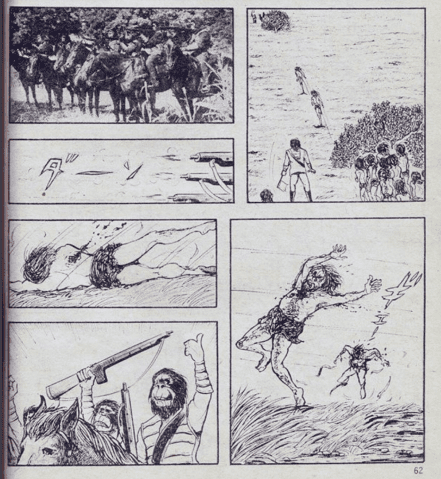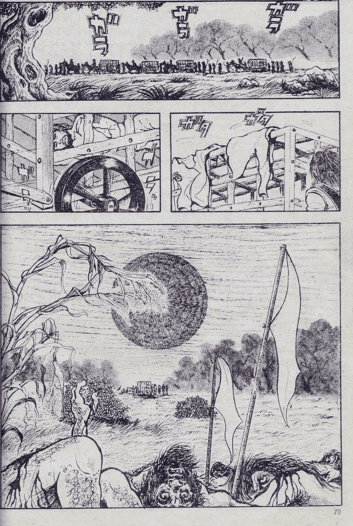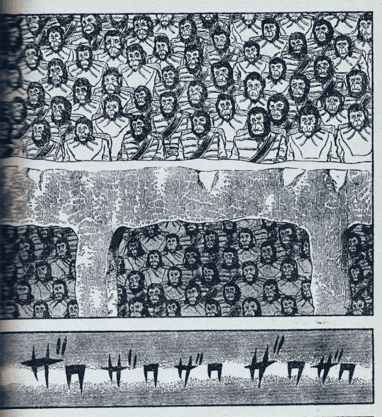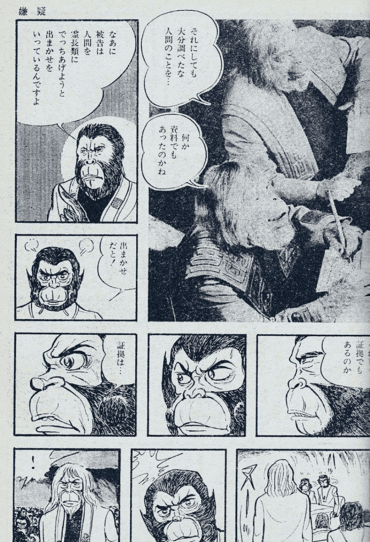It’s very difficult to be on the ball in the comic review game—to be up to the minute, or even ahead of the curve. Most comics are sent out to review in the same week that they are published and, for a lot of people, if you don’t have the book on order, you have to get to the shop on the day of release or miss it forever. That means waiting for the reviews to come out, to see what people are saying about a specific comic, will mean that it may be too late to pick up the ones that are getting the good reviews.
I know what I like, and I have certain titles that I will look out for, in Previews or publisher announcements—certain comics that I know I’m going to buy long before they come out so that I can make sure I get them on a pre-order. There aren’t many, but I know them when I see them. Dick Tracy from Mad Cave comics was one such title. And pretty much anything with Planet of the Apes in the title. Unfortunately, I missed out on Saru no Wakusei (the first Japanese adaptation of Planet of the Apes written by Kuroda Minoru) on account of not being born yet when it released in 1971. Luckily for me, after many years of hearing about, and seeing glimpses of artwork, Hunter’s Planet of the Apes Archives have recently made a full PDF available for download. And to say I was excited, is an understatement.

A small confession to start with, but one that’s important to this review: I can’t read Japanese. You would think that should be instrumental to the review of a Japanese comic and, in a way, I would agree. However, I am not aware that any English translation exists for Saru no Wakusei, and this allows me to ignore one aspect of adaptation that can prove to be a contentious point. Often, with adaptations, an audience can become fixated on the fidelity of script, of the actual speech within any given text. You can see this in Zack Snyder’s Watchmen where lines from the comic are spoken almost word for word in the movie, or in Marvel’s adaptation of Blade Runner, where the incessant voiceover from the film is placed into caption boxes throughout the pages of the comic. This obsession with accuracy highlights the limitations of one medium, and/or shines a light on the problems of one of the versions. To expand on the two examples given: the Watchmen movie demonstrates how the spoken word has different uses in comics than it does on film, thus repeating the comics script seems ungainly and awkward coming out of the actors’ mouths. In a film when character A bursts through a door and punches character B in the face, character B falls to the floor and says “ you punched me in the face,” the line is superfluous, unless you are going for a comedic angle. In a comic, one panel can have character A bursting through the door and panel be can have character B on the floor, speaking the same line. This time, the line acts as information, telling the reader what just happened without the need for a string of action panels. Also the line becomes less cheesy and lacks the comedic element it would on film because the audience reads it as information and therefore gives it a different tone.
The second example, Blade Runner, illustrates how cumbersome and intrusive the voiceover is in the movie. The comic book adaptation works beautifully, with the rolling inner monologue adding to the reading experience; even Harrison Ford hated the voiceover in the film. Which is why you should always watch the director’s cut.
But back to Planet of the Apes: Without needing to worry about looking for those famous lines represented within the pages of the comic, I can instead focus on the artwork and the layouts of the book, which is the real reason I’ve always wanted to read it. I know the story, I’ve seen the film hundreds of times, read the original novel a handful of times, and read the various adaptations from different publishers over the years. My interest here is the visual difference between the 1971 Japanese version and those that I am already familiar with.

The first thing that is noticeable is the cartoon style of the characters. They are more simplistic than, for example, the Marvel Comics interpretations in 1974, which could be classed as more realistic in representation. Saru no Wakusei demonstrates the reductive quality of the comics medium, proving that less can sometimes be more. There is a character guide in the first few pages which compares photo images of the characters from the movie with the drawn characters in the comic. This makes it easy from the start to see who are the main characters, but it’s not needed. It’s more of a presentation feature than a true guide. Following the story through, it’s easy to see who is who and, if you want to match them to the film, even without speech you know which ape is Zira and which is Zaius.
As stated, the characters are simplified, which allows for more panels on a page, or larger populated panels that aren’t too busy. There is also a lack of backgrounds, focusing instead on the characters, their actions and reactions. Marvel’s Planet of the Apes is highly detailed with quite complex settings; Saru no Wausei uses establishing panels at the start of a sequence to set the scene and then drops the backgrounds. This style is more often seen in earlier Western comics or cartoon based comics, such as children’s anthologies and the underground comix of the 1960s. This style is still very popular in modern manga and is one of the major differences between eastern and western comics.
Despite the characters being simplified, they still have a lot of life in them, as is illustrated when the Icarus crashes near the beginning of the comic. Throughout the sequence, the characters express shock at finding their crew mates dead, surprise as water bursts into the cabin, urgency in their attempt to escape, and are mournful for the loss of their ship and colleagues. All of this comes through the art work, the emotive facial drawings and the clever mix of close up and medium view panels.

The narrative follows the same structure as the original movie, however some scenes in this adaptation are extended to include longer, more drawn out fight sequences. The human space travelers especially put up a more of a fight than in the movie. When Taylor and the other astronauts run from the hunting gorillas, they just run in the movie, attempting to escape the unbelievable situation they have found themselves in. In Saru no Wakusei, they turn and fight the gorillas, standing up to them, at first in defiance and then in desperation. In turn, the gorillas are much more sadistic in their approach to the hunt. We see glimpses of pride and enjoyment in the movie, with the apes taking photos of each other with their human trophies, but again Saru no Wakusei is more violent, more brutal. The gorillas turn the hunt and their prey into a mindless sport. They allow the humans to run for their lives, two at a time and then gun them down before they can escape. They cheer and celebrate the brutality but are mortified when the violence is turned against them.
In this sequence, the creators are highlighting a much deeper difference between the astronauts and the apes on this new world. Where the original touched on elements of physical difference and racism, this Japanese translation extends the comparison to internal beliefs and actions. The apes don’t just look different but have a different philosophy and moral judgment to the humans. This is demonstrated later on in the comic when the apes scientists are shown to be experimenting on the humans—not just studying them like in the movie, but experimenting with their physiology, and grafting parts of the humans together to create monstrosities.
One of the major differences between the manga and the film, at least in the visuals, is how violent Saru no Wakusei is. The treatment of the humans by the gorillas is one thing, but the visual effects following the hunt are disturbing, with corpses left to rot in the beautiful landscape. In the labs, a monstrous creature literally tears itself apart, and a table is covered in the remains of a human body, dissected and tinkered with. And poor Taylor is constantly being violently hit on the head with a club. The fact he doesn’t suffer from some permanent brain damage is a miracle.
The highlights of this comic are the beautiful vistas that fill half pages, full pages, and even double page spreads. Although much of the comic features characters only in the panels, when the settings are used, they are outstanding. Ape City is a massive, tall, and imposing city, not the collection of small dwellings as seen in the film. It is befitting of the term city. When Taylor is put on trial, there are some amazing courtroom images, with hundreds of ape faces staring out of the page or, in one outstanding double page spread, the circle of apes stare inwards towards an ominous looking stone pulpit in the center of the image where the human Taylor is being led. The sense of scale really grabs you as you realize the size of this city and the vast number of inhabitants. The film uses long sequences of places, each populated with a few apes, to give the sense of size, but in this comic the true scale of the city can be expressed in a single, awe inspiring image.

At over two hundred and fifty pages, Saru no Wakusei is a fascinating adaptation of the American Planet of the Apes movie. It has some oddities, such as the inking changing color from black to red or blue for large sections, mostly in chapters 2 and 3. There are also the occasional still images from the movie inserted into a panel to replace the drawing that you would expect. There doesn’t appear to be any pattern to these inclusions and they are few and far between, but they do leap out when you get to them. The visuals in this comic are amazing and it is definitely worth looking at, even if, like me, you can’t read the text. A general knowledge of the movie will allow you to navigate the many pages but, in all honesty, the spectacular artwork and page layouts make up for any lack of understanding of the language. That said, I would love to get my hands on a translated version to read the script and see how it differs from the western versions that have appeared over time.

It may seem odd to recommend a Japanese comic that is over 40 years old, but Saru no Wakusei is visually beautiful, often harrowing, and a fascinating comparison to existing Planet of the Apes adaptations. If you are a fan of Planet of the Apes, then it is a must see and you need to get over the Hunter’s Planet of the Apes Archives and check it out. And while you are there, check out the vast collection of other Apes related things. There are some amazingly fascinating comics from all over the world.
And I will wait patiently for someone to translate this wonderful looking comic so that I can get the most out of this gorgeous piece of history.

